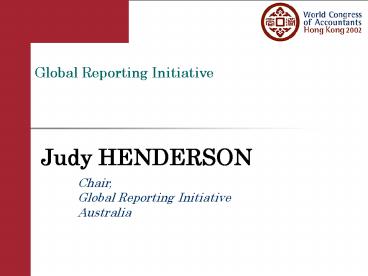KEY CHALLENGES IN GLOBAL CORPORATE CITIZENSHIP - PowerPoint PPT Presentation
Title: KEY CHALLENGES IN GLOBAL CORPORATE CITIZENSHIP
1
Global Reporting Initiative
Judy HENDERSON
Chair, Global Reporting Initiative Australia
2
AN INTRODUCTION TO THE GLOBAL REPORTING
INITIATIVE
- Dr Judy Henderson
- Chair
- Global Reporting Initiative
3
THE GLOBAL CONTEXT
- Accounting failures have taken accountability
from a business to a social issue Enron, Xerox,
WorldCom - Loss of public confidence in corporate governance
- Global markets mean global accountability which
needs global standards - New corporate value drivers need new measurement
tools and information
4
REPORTING ON THE RISE
Sustainability
Number of Reports
Environmental And EHS
www.globalreporting.org
4
5
BASIC PROBLEMS AND OPPORTUNITY
Companies receive diverse information requests
Stakeholders receive incomplete information
A globally-accepted reporting framework developed
through a multi-stakeholder process
www.globalreporting.org
5
6
TRANSPARENCY not OPTIONAL ESSENTIAL
www.globalreporting.org
7
GRI MISSION
Design and continually improve reporting
guidelines reflecting the three dimensions of
sustainability economic, environmental, and
social Revised 2002 Guidelines issued
Elevate corporate sustainability reporting to be
as routine as financial reporting Developing
protocols and assurance guidance
Build a global and independent institution to
become steward of the Guidelines Incorporat
ed as Foundation in Netherlands with new Board
8
GRI A BRIEF HISTORY
- Conceived in 1997 by CERES in partnership with
UNEP - Multi-stakeholder process rooted in principles of
balance, transparency, independence - Funded by foundations through 2002, now
diversifying - Moved from Boston to Amsterdam in Sept. 2002
- Governed by multi-stakeholder Board, Stakeholder
Council and Technical Advisory Council
9
GRIS PORTFOLIO
The Guidelines foundation document upon which all
other GRI documents are based
Technical protocols address a specific set of
indicators, providing technical guidance on their
measurement
The Guidelines
Energy Water Child labour
Sector supplements additional guidance for
specific sectors, addressing issues pertinent to
those industries
Issue supplements issue-specific supplements to
provide additional models for organising the
information
Automotive Financial Tourism Mining
Diversity Productivity HIV/AIDS
10
REPORTING ELEMENTS
environmental
www.globalreporting.org
27 May, 2002
11
WHAT IS A GRI REPORT?
Vision and Strategy Description of the reporting
organisations strategy with regard to
sustainability, with text discussion and a
statement from the CEO Profile Overview of the
reporting organisations structure, policies and
management systems, including stakeholder
engagement efforts Governance structure and
management systems Description of organisational
structure, policies and management systems
including stakeholder engagement efforts GRI
content index A table supplied by the reporting
organisation identifying where the information
listed in the Guidelines is located within the
report Performance indicators Measures of the
impact or effect of the reporting organisation
divided into economic, environmental and
social
12
SUSTAINABILITY REPORTING PRINCIPLES
- Transparency
- Inclusiveness
- Sustainability context
- Completeness
- Relevance
- Neutrality
- Comparability
- Accuracy
- Clarity
- Timeliness
- Auditability
13
GRI COMPLEMENTARY INITIATIVES
Management Systems Standards
Codes of Conduct
GRI seeks to harmonise and integrate
Intangibles Accounting
Performance Standards
GRI
- GRI as a core platform for sustainability
reporting
Issue/ Sector/Natl Reporting Guidelines
International Conventions
Assurance Standards
www.globalreporting.org
13
14
WHY COMPANIES USE THE GUIDELINES
- Benchmark and enhance efficiency
- Internal management improvements
- Stakeholder consultation
- Attract employees and investors
- Manage risk and protect reputation
15
EXPOSURE AT WSSD IN JOHANNESBURG
- Launch of 2002 Guidelines
- GRI reference in official documentation
- GRI reference by heads of government and UN
Secretary-General - GRI recognised mechanism for demonstrating
adherence to Global Compact
16
2002 GUIDELINESWHATS NEW?
- Reformulated reporting principles
- Strengthened social and economic content
- Core versus additional indicators
- Clarity on flexibility
- Guidance on assurance
17
BALANCING FLEXIBILITY COMPARABILITY
IN ACCORDANCE
Transparency
Structure
Incremental Reporting
INFORMAL
Coverage
www.globalreporting.org
18
IN ACCORDANCE REQUIREMENTS
- Report on vision, profile of organisation and
governance and management systems - Include a GRI Content Index.
- Report on the core performance indicators.
Omission of each core indicator must be explained
- Ensure that the report is consistent with the
reporting principles - Include a statement by the Board or CEO as
follows This report has been prepared in
accordance with the 2002 GRI Guidelines. We
believe that this report is a balanced and
reasonable representation of our organisations
sustainability performance.
19
VERIFICATION ASSURANCE
- Key to strengthening credibility
- 2002 Guidelines encourage the independent
assurance of reports and the development of
standards and guidelines for the assurance
process
20
CHALLENGES AHEAD
- Strengthening/explaining linkages to financial
reporting and financial industry - Strengthening harmonisation with key complements,
e.g., ISO, EC CSR, AA1000S - Rolling out supplements and protocols
- Expanding engagement SMEs, sectors, regions,
- Harmonisation with government initiatives
www.globalreporting.org
21
GLOBAL REPORTING INITIATIVE
"Another important development is the growing
support for the Global Reporting Initiative,
which offers a coherent framework for reporting
on environmental and social issues. It is a
crucial complement to the Global Compact, and I
am very pleased that the United Nations
Environment Programme is a driving force behind
both of them."Kofi Annan UN Secretary General1
September 2002
www.globalreporting.org































